|
 My article on “Gods, Demons And Consciousness – The allure of Mount Kailash” has featured in August 2013 issue of Asian Geographic magazine. The relevant pages from the magazine can be viewed by clicking on the images below and scrolling. I have also provided the article content in text format for ease of reading.............Amardeep Singh My article on “Gods, Demons And Consciousness – The allure of Mount Kailash” has featured in August 2013 issue of Asian Geographic magazine. The relevant pages from the magazine can be viewed by clicking on the images below and scrolling. I have also provided the article content in text format for ease of reading.............Amardeep Singh
Click image to enlarge
Gods, Demons And Consciousness – Allure of Mount Kailash
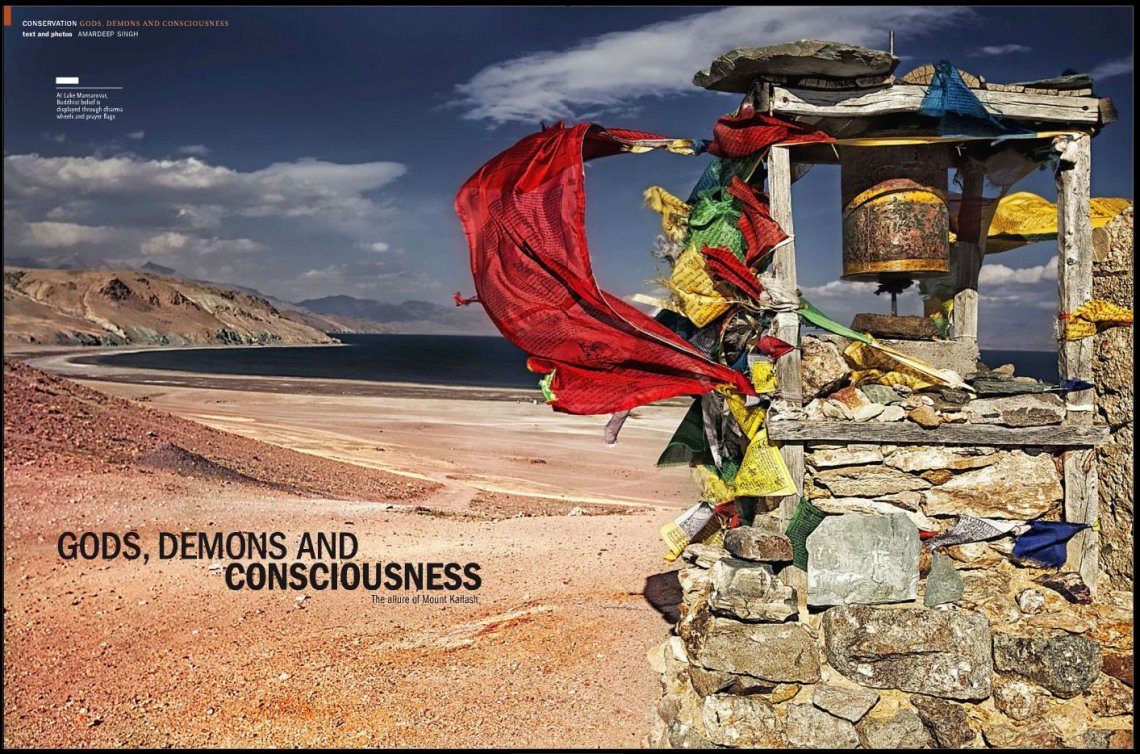
Aug 29, 2013: There are many lakes and mountains around the world, though only a few have an aura and character that can continue to attract people over the ages. In the remote western region of Tibet lies a triad formation of Mount Kailash, Lake Mansarovar and Lake Rakshastal, possessing a unique magnetic force that has for centuries attracted the followers of Buddhism, Hinduism, Jainism and Bon religions.
Mount Kailash (Tibetan : Kangriboqe, Chinese : Gang Ren Bo Qi Feng) at a height of 6,638 metres, stands isolated on the Tibetan plateau. It’s four sides are so regular that it appears to be the dome of a temple, rising from the base of the Tibetan plateau at 4,572 metres. Lying 40 km south of it, are the lake Mansarovar (Tibetan : ma-pham g.yu-mtsho, Chinese : Ma Pang Yong Cuo) and lake Rakshastal (Tibetan : Lagngar Co, Chinese : La Ang Cuo).
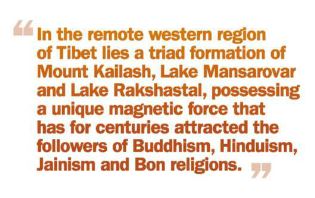
Lake Mansarovar lies at 4,600 metres and is the world’s highest fresh water lake, supporting countless species of fishes, birds and plants. It is nestled in the massif around Mount Gurla Madhata (Tibetan : Naimonanyi, Chinese : Namu Nani), which is at a height of 7,694 metres, rising south of the lake.
Lake Rakshastal, at a height of 4,292 metres, lies a short distance east of Mansarovar. In stark contrast, this is a salt water lake that supports few forms of life.
Through its fresh and calm water, Lake Mansarovar invokes a feeling of peace, while bareness and strong winds found at Lake Rakshastal create a feeling of harshness and turmoil. The former is situated towards east and latter to the west. In Tibetan art, the rising sun from east therefore results in pictorial representation of Mansarovar as Sun and that of Rakshastal as Moon. Interestingly, the aerial views of the two lakes are also in stark contrast. Mansarovar with it’s circular form, does indeed look like the Sun, while the semi-circular form of Rakshastal evokes the crescent moon.
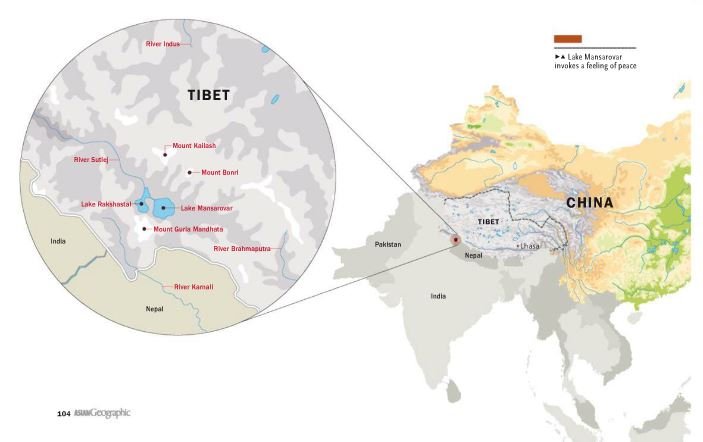
The positive, peaceful aspects of Lake Mansarovar have therefore resulted in it’s association with gods, whereas the opposite traits of Lake Rakshashtal have linked it to demons. And to the north of these lakes, stands the mighty Mount Kailash, representing metaphysical consciousness.

Aspiring pilgrims to this region, first take a dip in the Lake Mansarovar, an act that is believed to bring them closer to the positive forces that represent the gods. They then proceed to Mount Kailash to perform a Kora (religious walk circling the mountain) over a two – to – three day period, which signifies the purification of human Consciousness. It is also very interesting that none of the pilgrims ever aspire to visit Lake Rakshastal, despite being no less beautiful, in it’s own way.
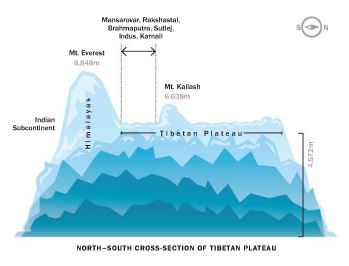 To appreciate the association of Consciousness with Mount Kailash, one needs to see an aerial view of its landscape. Within it’s proximity, radiating like spokes from the hub of a wheel, four mighty rivers of Asia take course towards the east, west, northwest and south. These rivers are the Brahmaputra (Tibetan : Tamchog Khabab), Indus (Tibetan : Senge Khabab), Sutlej (Tibetan : Langchen Khabab) and Karnali (Tibetan : Magcha Khabab). The Brahmaputra and Karnali (the source of the Ganges) drain into the Bay of Bengal, while the Sutlej and Indus find their way to the Arabian Sea. To appreciate the association of Consciousness with Mount Kailash, one needs to see an aerial view of its landscape. Within it’s proximity, radiating like spokes from the hub of a wheel, four mighty rivers of Asia take course towards the east, west, northwest and south. These rivers are the Brahmaputra (Tibetan : Tamchog Khabab), Indus (Tibetan : Senge Khabab), Sutlej (Tibetan : Langchen Khabab) and Karnali (Tibetan : Magcha Khabab). The Brahmaputra and Karnali (the source of the Ganges) drain into the Bay of Bengal, while the Sutlej and Indus find their way to the Arabian Sea.

Water is an essential element to create and sustain life. Since life springs in physical elements through presence of Consciousness, the Kailash landscape, which is the source of water for the Asian subcontinent, is therefore associated with Supreme Consciousness itself.
Modern day politics has now created distinct nation based landmasses, but in the past this region was a confluence of cultures from India, Nepal, Tibet and China; the influence of language in the popular names of the mountains, lakes and rivers is clear evidence for this. While nestled in the Tibetan territory, they are still popularly called by their Indian (Sanskrit) names.

To Hindus & Buddhists, Mount Kailash is metaphysically referred as Meru, and seen to be the centre of universe. Just as subatomic particles are essentially microcosmic replicas of the vast universe, so too is the psychophysical organism of the human body. Meru in the human body is represented by the point inside the nervous system into which the spinal cord extends. It is believed that human Consciousness resides here. So is the metaphysical location of Mount Kailash is seen to be the consolidation of universal Consciousness.
To Hindus, Mount Kailash is the seat of Lord Shiva, the form of God that destroys ignorance and illusion. It is on this mountain that he sits in a state of infinite meditation. Devout Hindus view the three horizontal lines on the South face of Mount Kailash, where the steep gradient cannot support snow, as the symbol of the followers of Lord Shiva.
Buddhists, on the other hand, associate Mount Kailash with Milarepa (1052 AD), a teacher of Tantric Buddhism, who challenged Naro Bon-Chung, champion of the pre-historic Bon religion of Tibet. Their debates, having resulted in no conclusive supremacy, led to an agreement that whoever reaches the summit of Mount Kailash first would be considered the victor and his philosophy would prevail in Tibet. Naro Bon-Chung used magic drums to rapidly ascend, while Milarepa sat at the base of the mountain in a deep meditation. Breaking his trance, he suddenly moved into action and rode on the rays of the sun that had started to descend from the top of the mountain – reaching the mountaintop before Naro Bon-Chung. At the peak, he picked some snow and threw it on the top of a nearby mountain, called Bonri, signifying that even though Tantric Buddhism would become supreme in Tibet, the Bon religion would continue to have a footprint.
For the followers of Bon, a religion that predates Buddhism, it is their belief that the entire region of Kailash and it’s surrounding lakes are a seat of spiritual power. Jainism, a religion from India, associates the region with their first teacher, Tirthankara Rishabhdeva. It is here that he is believed to have achieved spiritual liberation.
Like the spiritual aspects of Mount Kailash, lake Mansarovar too finds it’s importance in many religious beliefs. In Hindu mythology, Mansarovar was carved by Brahma (the god of creation) for his Son to bathe in after meditating at the nearby Mount Kailash. Metaphysically, Mansarovar (Manas, meaning “mind”; Sarovar, meaning “lake”) is where one finds a sacred goose (or swan) called Hamsa whose whiteness symbolizes purity. For Buddhists, the lake is associated with Maya, Buddha’s mother, who is believed to have conceived Buddha around this lake. It is also believed that later in his life, Buddha himself visited the lake.
Guru Nanak, the first Guru of the Sikh faith, which was founded in the plains of Punjab in India & Pakistan, is also believed to have traveled to Tibet and stayed around the lake Mansarovar. The Sikh scripture , Guru Granth Sahib, says that while spiritual seekers search the unfathomable presence of God by visiting worldly places like temples, mountains, lakes, and so on, but with a right frame of mind, God can be well realized within oneself in any place.

Rakshastal, whose Tibetan name Lagngar Co, has a similar sounding to the name “Lanka” from the country Sri Lanka. In Hindu mythology, it is believed that Sri Lanka was once ruled by Ravana, a ten-headed demon king. Ravana confronted Rama, the God king, and this is described in the Hindu mythological scripture, the Ramayana. According to Hindu belief, Ravan created Lake Rakshastal to gain supernatural powers by meditating on it’s banks, in close proximity to Mount Kailash. With this association with Ravana and its lifeless waters and gusting winds, the lake is given a wide berth by spiritual seekers, who have no desire to be drawn in by its negative energy. Yet the lake remains a sepctacular natural wonder, despite its notorious image. After all, it too is God’s own creation!
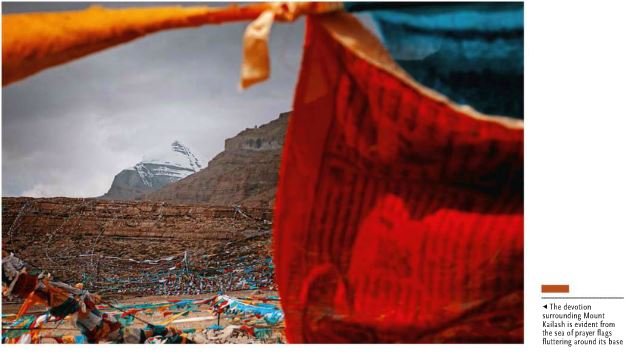
Profoundness of belief, mythology and history of this region were also the reason why the majority of the monasteries here were destroyed during the Chinese cultural revolution of 1966 to 1976. Chairman Mao, who led the movement, is believed to have said, “Religion is poison”. Not only were the Tibetan Buddhists not able to practice their beliefs for years after the revolution, the region was also closed to Hindu and Jain spiritual seekers from India. No foreigners were allowed in this area till the 1980. Even now, travel in Tibet remains highly restricted and requires a lot of planning.
However the true personality of a place lies in it’s power to consistently influence it’s believers. Tibet has again started attracting Hindus, Buddhists, Jains and Bon followers. Today’s generations yearn to experience the aura of this terrain.
Lama Anagarika Govinda, in his book The Way of the White Clouds, summarizes the essence of this region perfectly : “Take away a few thousand feet from the altitude of Mount Everest, or any of the other famous big mountains of the Himalayas, and nothing outstanding would remain of them; they would simply disappear from the map and merge into the myriad of unknown or unnoticed peaks and mountain massifs, But even if one would take away a few thousand feet of Mount Kailash, it still would retain its importance, its unique central position in the general pattern of mountain ranges and the river systems of Tibet and India”. |




